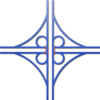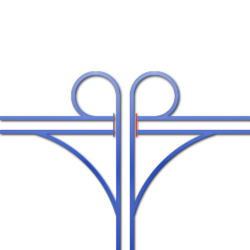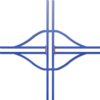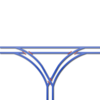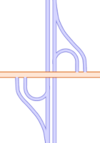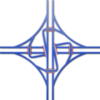MRT Interchange Agency
| MRT Interchange Agency | |
|---|---|
| Staff | |
| Founder/CEO | Derpy_Melon |
| Co-CEO | mjpwwf |
| Our Products | |
| Interchanges | Cloverleaf Half Cloverleaf Diamond Directional T Trumpet Half Trumpet Windmill |
The MRT Interchange Agency is a company that focuses on helping people build interchanges. We can do all sorts of interchanges from Diamond Interchanges to Cloverleaf Interchanges.
Types of Interchanges
Cloverleaf
A cloverleaf interchange is typically a two-level, four-way interchange where all turns across opposing traffic are handled by non-directional loop ramps. Assuming right handed traffic, to go left vehicles first cross over or under the target route, then bear right onto a sharply curved ramp that turns roughly 270 degrees, merging onto the target route from the right, and crossing the route just departed. These loop ramps produce the namesake cloverleaf shape.
Half Cloverleaf
A half-clover interchange is essentially half a cloverleaf interchange, constructed to connect in just three directions instead of four. These are rarely used due to the traffic weaving that they cause and the large amount of land that they consume, but they can be built in areas where the connecting ramp along the loop of a trumpet interchange is not feasible due to building developments or physical limitations. Half-clovers are designed to be readily upgraded to full cloverleaves if the terminating highway is ever extended past the through highway.
Diamond
A diamond interchange is an interchange involving four ramps where they enter and leave the freeway at a small angle and meet the non-freeway at almost right angles. These ramps at the non-freeway can be controlled through stop signs, traffic signals, or turn ramps.
Directional T
A full Y-interchange (also known as a directional T interchange) is typically used when a three-way interchange is required for two or three highways interchanging in semi-parallel/perpendicular directions, but it can also be used in right-angle case as well. Their connecting ramps can spur from either the right or left side of the highway, depending on the direction of travel and the angle.
Trumpet
Trumpet interchanges are used where one highway terminates at another highway. These involve at least one loop ramp connecting traffic either entering or leaving the terminating expressway with the far lanes of the continuous highway.
Half Trumpet
A partial cloverleaf (also known as a half trumpet interchange) is usually used in a freeway to non-freeway interchange. In this interchange, the top road must be the non-freeway as the on/off ramps go down into the freeway. There is a loop ramp and a directional ramp. The loop ramp is for getting off the freeway and the directional ramp is to get onto the freeway. The point where the ramps meet the non-freeway road is usually a T intersection which means it requires traffic lights or a stop sign.
Windmill
Vehicles make right and left-turn movements at the ramp intersections and are removed from the main intersection in conventional intersection design. Left turns can turn into left merge lanes, so vehicles have to wait for gaps in arterial traffic in only one direction.
Our Work
- Trumpet interchange where the A5-West terminates at A5-North.
- Trumpet interchange where Port Local Road terminates at Route 9.
- Half Cloverleaf interchange where the B80 terminates at Main Street in Risima.
- Trumpet interchange where a road to Southern Pine Mountain terminates at Old Town Ave in Pine Mountain.
Interchange Diagrams Taken From Wikipedia.
